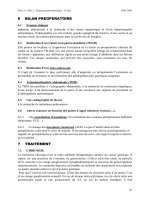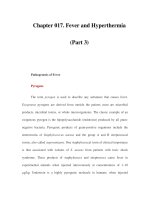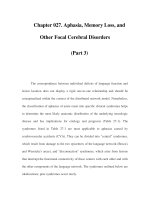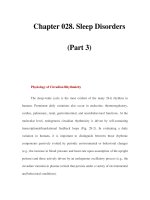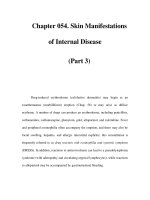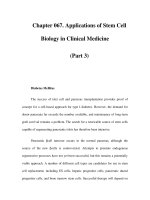Kaplan anatomy coloring book - part 3 pot
Bạn đang xem bản rút gọn của tài liệu. Xem và tải ngay bản đầy đủ của tài liệu tại đây (722.93 KB, 21 trang )
Chapter
Four:
Articulations
85
g._
h. _
a. _
Fibrous joints are held together by
collagenous fibers, the same fibers
that make up tendons
and
ligaments.
These joints do
not
have a joint
cavity.
Sutures
are immovable
fibrous joints
of
the skull. Color in
the suture illustrated on the page. A
gomphosis
is a fibrous joint in
which a
round
peg is held into a
socket. Gomphoses are represented
by the teeth held into the maxilla or
the mandible. Another fibrous joint
is the syndesmosis. This joint is
found between the distal radius
and
ulna (or tibia and fibula)
and
is
semimovable. Color in the various
fibrous joints.
FIBROUS
JOINTS
Articulations
are the joints that
occur between bones.' They can be
classified either according to
movement or by structure. Joints
can be immovable
(synarthroses),
semimovable
(amphiarthroses),
or
freely movable
(diarthroses).
The
composition
of
joints can be
fibrous, cartilaginous, or synovial.
CLASSIFICATIONS
OF
ARTICULATIOI\IS
Answer Key:a. Gomphosis
(peg suture), b.
Tooth,
c. Alveolar
socket,
d.
Gingiva,
e.Alveolarridge,
f.
Periodontal ligaments,g.
Suture,
h.
Sagittal
suture,
i.
Syndesmosis,
J.
Tibia,
k.
Fibula,
1.
Interosseous
membrane, m.
Posterior
tibiofibular
ligament,n.
Transverse
tibiofibular
ligament
1. _
J.
CARTILAGINOUS
JOINTS
Cartilaginous joints are bones held
together by cartilageand do not
have a joint cavity. If the joint is held
together by hyaline cartilage it is
known as a synchondrosis.
If
the
cartilage is short then the joint is
immovable. An example of this kind
of joint isan epiphysealplate. If the
cartilage is a little longer then the
joint is a semimovable joint. This is
represented by the
sternal-rib
junction.
A cartilaginous joint that
iscomposed of fibrocartilage is
known as a symphysis (symphyses
plural). These are semimovable
joints. Examples of symphyses are
the pubic symphysis and
intervertebral discs. Color the
cartilaginous joints. Use different
colors for the hyaline cartilage from
the fibrocartilage.
Answer Key: a.
Synchondrosis,
b.
Sternum,
c.
Costal
cartilage,
d.
Ribs,
e.
Femur,
f.
Epiphyseal
plate,
g
Symphysis,
h. lntervertebrai disc,
i. Lumbar
vertebra,
j.
Sacrum
b
c. _
a. _
f. _
g._
Chapter Four I
mKAPeLANd·
-Ical
87
Articulations
d. _
1. _
J
SYNOVIAL
JOINTS,
BURSA,
AND TENDON
SHEATH
Synovial joints are complex joints
that are all freely movable. There are
variations
with
the joints
but
all
synovial joints
con~ist
of two
bones
enclosed by a
joint
capsule,
articular
cartilages, synovial
membranes
that secrete synovial
fluid in the synovial cavity. Some
synovial joints have fibrocartilage
pads in the cavity called
menisci
(meniscus
singular). Color the
synovial joint and pay attention to
the general structure of the joint.
Color each
part
of the joint
°a
different color.
MODIFIED
SYNOVIAL
STRUCTURES-BURSAE
AI\ID
TEI\IDON
SHEATHS
There are structures in the body that
consist of svnovial
membranes
and
fibrous capsules, These are not
synovial joints but are associated
with joints. A bursa is one such
structure.
It
is a fluid-filled sac
with
an internal synovial
membrane
that
cushions tendons as they pass over
bones. The bursa occurs between the
tendon
and
the bone. Another
structure is a tendon sheath. It also is
composed of a synovial
membrane
and
fibrous sheath
and
it encloses
tendons. The sheaths can provide
lubrication to the
tendon
so it does
not become irritated as it passes over
bones or next to other tendons.
Color in the layers of the
bursa
and
the
tendon
sheaths.
Answer
Key:
ao
Bone, b.Joint capsule,
c.
Synovial
cavity
(synovial
fluid),
d.
Meruscus,
e.
Articular
cartilage,
f.
Synovial
membrane, g. Tendon
sheath, h.
Achilles
tendon,
i.
Bursa,
j. Calcaneus
Chapter Four I
mKAPeLA~·lcal
89
Articulations U
a. _
b. _
c
d. -
e. _
g
h
_
Chapter Four I
KmAP~~·ICal
91
Articulations
ItnI
SPECIFIC
SYNOVIAL
JOINTS
Synovial joints are classified by what
kind of
motion
they have. Gliding
joints
move in one plane like two
sheets of glass sliding across one
another. Hinge
joints
have angular
movement like a
door
hinge.
Rotating (pivot)
joints
move like a
wheel of a car
around
an axle.
Condyloid
(ellipsoidal)
joints
move
like hinges in two directions. In these
joints there is a convex surface and a
concave surface.
Saddle
joints
have
two concave surfaces. They allow for
greater movement than condyloid
joints. Ball
and
socket joints allow
for the greatest range of movement
and are found in the shoulder
and
hip. Color the illustrations of these
joints.
c
a. _
Answer Key: a. Superiorarticular
process,
b.
Vertebrae,
c. Inferiorarticular
process,
d. Gliding(plane), e. Humerus,
f
Ulna,
g.
Hinge,
h.
Ulna,
i.
Radius,
j,
Rotating
d. - _
g._
~h_
1. _
J.
11
_
.r'
,/
NOVIAl
SPECIFIC
~NTINUED)
JOINTS
(C
a.
!
KAPLAN". I
Chapter
.Four
medica
ArticulatIons
93
b Ball-and-
K "a Femur, .
Answer e
y
d"··
d Carpals,
k
t
Ra
IUS, . .
soc e ,c. . f Trapezium,
e.
Condyloid,.
\ h Saddle
First metacarpa, .
g.
d.
c.
e.
g.
h.
Chapter Four I
m
KA
Pe
LA
Nd'
.·cal
Articulations
95
b. _
a. _
SPECIFIC
JOINTS
TEMPOROMANDIBULAR
JOINT
Som.ejoints of the bodywarrant
special attention. The
!e~P?romandibular
joint
or jaw
joint
IS
both
a gliding jointand a
hinge joint. The condyle of the
mandible articulates with the
mandibular
!ossa of the temporal
bone. An
articular
disc is found in
the joint that decreases the stress on
the joint. Ligaments (dense
connective tissue that joins bone to
bone) connect the mandible to the
temporal bone.
Answer Key: a.
Temporal
bone
b.
Coronoid
process,
c.
Condyl~ld
process
(CUI),
d.
Angle
of mandible
e.
Mandibl,.
f.
Articular
disc,
g
Capsule,
h.
Hinge,
I. Hingeandglide
Jaws closed
e. _
h
Jaws
opened
widely
Actions:
1
c)
//
;
.
~V
//
. ,r
~ =' d.
HUMEROSCAPULAR AND
ACETABULOFEMORAL
JOINTS
The
humeroscapular
joint
or
shoulder joint isa ball-and-socket
joint that connects the
humerus
to
the glenoid fossa of the scapula. The
joint isdeepened by the glenoid
labrum
which is a fibrocartilage
ring. There are numerousligaments
that connect the scapula to the
humerus.
Another ball and socket joint is the
acetabulofemoral joint. It also has
an acetabular
labrum
and
numerous ligaments that jointthe
femur to the hip.
Answer
Key:
a.Articular cartilage,
b. Glenoid labrum,
c. Capsule,
d. Glenoid fossa, e. Humerus,
f.Scapula, g.Shoulder joint,
h. Femur,
i. Acetabular labrum,
j.Hip
joint
a. _
c. _
d.
e. _
h. _
Chapter Four I
IlAPLAlf
d
-
I 97
Articulations me lea
g._
1. _
TIBIOFEMORAL
JOINT
The tibiofemoral
joint
is special in
humans because it is the largest joint
in the body and because it is
particularlyvulnerable to injury. The
joint is stabilized by the
patellar
tendon,
the
medial
and lateral
collateralligaments, the
anterior
and
posterior
cruciate ligaments
and the medial and lateral menisci.
Label the structures in the anterior
view,with the patella in place and
with it reflected, and color them in.
Answer
Key:
a. Femur, b. Patella,
c. Fibular collateral ligament,
d. Patellar tendon, e. Tibial collateral
ligament,
f.Fibula, g.Tibia,
h. Posterior cruciate ligament,
i.Anterior cruciate ligament,
j. Lateral meniscus,
k. Medial meniscus
g.
Chapter Four I
IAPLAN
d
·· I
99
Articulations me lea
b. _
h. _
k.
-T+H-T++ fc7* + _+_
b. _
Chapter Four I
KAPLAN
d'. I 101
Articulations
me lea
MOVEMENT
AT
JOINTS
where the joint is extended beyond anatomic position. Looking up at the
ceiling is hyperextension of the head.
There is a broad range of motion that occurs at joints. These motions
should be referenced with the body in anatomical position.
Flexion of a
joint is a decrease in the jointangle from the body in anatomic position.
When the elbow is bent the forearm is flexed.Most flexion takes place in
a forward direction. The exception to this is the leg where flexion of the
leg results in the bending
of
the knee. Extension
of
the
joint
is when the
joint is returned to anatomic position.
Hyperextension is a condition
Abduction occurs when the extremities or head are moved in the
coronal plane, laterally from the body.
Adduction is the return of the
limbs to the body.
Rotation is the movernen t of part of the body in a circular pattern.
Lateralrotation is the movement
of
the body in a lateral direction and
medial rotation is in the opposite direction.
1\
e.
I~(I~
)dJ
~'-~'\~'-~
~
\\
d. _
~"' ~
J
f//
b
c. _
-)
(
x;
I
I
sv
J l
i
(
f.
~
g.
a.
Answer
Key: a. Hyperextension of the head, b. Flexion of the forearm, c.Extension of the forearm, d. Abduction of the arm, e. Adduction of the arm,
f.Medial rotation of the thigh, g. Lateral rotation of the thigh
OVERVIEW
OF THE
NERVOUS
SYSTEM
The body must react to the external
environment and the internal
environment and communicate
information between regions of the
body. This job is primarily the task
of the nervous system. Proper
response to the external
environment iscritical for thermal
regulation, response to threats,
taking advantage of opportunities
such as food availability, and a host
of other stimuli. Response to the
internal environment is
important
for sensing muscle tension, digestive
processes, maintenance of blood
pressure, and other functions.
Communication is
important
for
coordination of activities such as
walking, digestion, and maintenance
of blood pressure. The nervous
system also integrates information
from the environment, relates past
information to the present and
interprets new experiences. The
brain
and the
spinal
cord
make up
the
central
nervous system. The
nerves of the bodymake up the
peripheral
nervous system. The
peripheral nervous system is divided
into the
somatic
nervous system
which consists of
spinal
nerves and
peripheral
nerves that innervate the
outer regions of the body. It also
consists of the
autonomic
nervous
system. Label the parts of the
nervous system and color them in.
Answer
Key: a. Centralnervous system,
b.
Brain,
c.
Spinal
cord,
d.
Peripheral
nervous
system,
e.
Spinal
nerves,
f.
Peripheral
nerve
Chapter
Five:
Nervous
System
103
d. _
\ \
NEURON
The nerve cell or
neuron
is the
functional cell in the nervous
system. Most electrical conduction
in the body is due to the
transmission of impulses by the
neuron. The neuron consists of
branched structures called
dendrites. The main portion of the
nerve cell is called the
soma
or nerve
cellbody, and the elongated part of
the neuron is the axon. Twoneurons
are connected by gaps called
synapses. The nerve cellbody is the
metabolic center of the cell
consisting of a nucleus, an
endoplasmic reticulum called the
Nissl bodies, and a region where the
axon attaches called the axon
hillock. Color in the parts of the
neuron and label the parts.
Answer Key:a.
Dendrites,
b. Nervecell
body (soma), c.
Nissl
bodies,
d.
Axon
hillock,e. Axon,f.
Synapses
e.
f. _
Chapter
Five
I
KmAPeLAN
d
'
.·cal
105
Nervous System
b.
NEUROGLIA
Neuroglia or glial cells have many
specialized functions in the nervous
system. The
neurolemmocyte
or
Schwann cell is found in the
peripheral nervous system. These
cells make up the myelin
sheath
that
wraps
around
axons.
The other neuroglia are located in
the central nervous system.
Astrocytes are glial cells that, along
with the brain capillaries, are found
in the blood-brain barrier. They also
have a role in transferring nutrients
from the capillaries to the deeper
regions of the brain. Another glial
cell that functions as a barrier is the
ependymal cell.These cellsare
located between the CNS
and
cavities filled with cerebrospinal
fluid. Microglia are also found in
the CNS and their function is one of
protection. Microglia respond to
invasions of the nervous system
and
they destroy microbes.
Oligodendrocytes are neuroglia that
produce myelination in the CNS.
Myelinated nerve fibers comprise
white matter. Myelinated fibers
conduct impulses faster than
unmyelinated fibers. White matter is
mostly associated with transmission
of neural impulses from one area to
another. Color each glial cella
different color and write the
name
of
each cell in the space provided.
Capillary
Neurons
d. _
g
Chapter
Five
I
UPLA~.
I 107
Nervous System meulCa
b
Answer Key:a.
Astrocyte,
b.
Ependymal
cell,
c.
Microglial
cell,
d. Oligodendrocyte,
e. Neurolemmocytes
(Schwann
cells),
f.
Myelin
sheath,
g.
Axon
NEURON
SHAPES/SYNAPSE
Neurons come in a fewbasic shapes.
The most common neuron in the
eNS
isthe
multipolar
neuron.
It
consists of many dendrites and a
single axon. Bipolar
neurons
are not
very common. They are found in the
eye,in the nose, and in the ear
and
consist
of
a singular dendrite
and
an
axon. Pseudounipolar
neurons
make up the sensory nerves of the
body. They consist
of
a cluster
of
dendrites at one end, a long axon
leading to the nerve cell body, and
another axon leaving the nerve cell
body at the same area.
Neurons connect to each other by
synapses. The
neuron
first carrying
the information is called the
presynaptic
neuron.
This
neuron
has synapticvesicles that release
neurotransmitters.
The synaptic
cleft is the space between the
neurons and the
postsynaptic
neuron
is the receiving neuron.
Labelthe various neurons and their
parts as wellas the synapse between
the neurons.
Chapter
Five
I UPLANd'· I
109
Nervous System me lea
a. _
Answer Key: a.Dendrites, b. Nervecell
body,c.
Axon,
d. Multipolar neuron,
e. Bipolarneuron,
f.Pseudounipolar
neuron,g.
Presynaptic
neuron,
h.
Postsynaptic
neuron, i.
Synaptic
vesicles,
j.
Synaptic
cleft,
k. Neurotransmitter
d. _
k. _
e. _
f.
__
~
_
.1
NEURAL
DEVELOPMENT
The nervous system develops early as
a neural groove. This groove folds in
on itself to become a neural tube as
early as four weeks after conception.
Atabout six weeks of age the
beginning cerebral hemispheres can
be seen as lateral enclosures from the
neural tube along with the
developing eye just posterior to the
hemispheres. This embryonic brain
is divided into three regions, the
prosencephalon
or forebrain, the
mesencephalon or midbrain, and
the
rhombencephalon
or hindbrain.
Label the parts of the embryonic
brain and the adult derivatives of
that brain and color in the regions.
Chapter
Five
I UPLANd'· I 111
Nervous System me lea
e. _
~'ta,
Q[f£
_
\.·.tr~\
b
~)\
;1
I \
~
\
(\
,
\
.• •
~
.;
//
c.
\
/i
I
rt[
\r.j
.
f.,,·
r
.,' \ d.
1,·.;1
I'.
1[1
Frontal section Frontal section
4-week embryo 6-week embryo
Answer Key: a.
Prosencephalon,
b. Mesencephalon,
c. Rhombencephalon, d.
Spinal
cord,
e.
Cerebral
hemisphere, f. Developing
eye,g.
Forebrain,
h. Midbrain,
i. Hindbrain
Lateral view
4-week embryo
g._
Lateral view
6-week embryo
1. _
LATERAL
ASPECT
OF
THE
BRAIN
The most obvious features of a lateral view of the brain are the lobes of
the cerebrum and the cerebellum. The most anterior lobe is the
frontal
lobe, which is responsible for intellect and abstract reasoning,
among
other things. The division between the frontal lobe and the
parietal
lobe
is the
central
sulcus. Just anterior to the central sulcus is the
precentral
gyrus, an area that sends
motor
impulses to muscles of the body. Just
posterior to the central sulcus is the
postcentral
gyrus.
The postcentral
Chapter
Five
I
KAPLA~.
I 113
Nervous System
me"dCa
gyrus receives sensory information from the body. On the lateral aspect
of the brain is the lateral fissure and inferior to this is the
temporal
lobe
of the brain. Hearing, taste, smell, and the formation of memories all
have centers here. The most posterior
part
of the cerebrum is the
occipitallobe, which has visual interpretation areas. Label the regions
seen in a lateral view of the brain and the spinal cord. Color the
precentral and postcentral gyri and then color the lobes of the brain.
Shade in the cerebellum as well.
e. _
d. _
c
_
b. _
a. _
Answer
Key: a. Temporal lobe, b. Lateral fissure, c. Frontal lobe, d. Precentral gyrus,
e. Central sulcus, f. Postcentral gyrus, g. Parietal lobe, h. Occipital lobe,
I. Cerebellum
SUPERIOR
ASPECT
OF
THE
BRAIN
From the superior aspect, the two cerebral
hemispheres
are divided by
the
longitudinal
fissure. The frontal lobes are separated from the
parietal lobeby the
central
sulcus. The
precentral
gyrus
(primary
motor
cortex) and the
postcentral
gyrus
(primary
somatosensory
a. _
b.
c.
d.
' '-
e. _
f. _
g
h.
Chapter
Five
I
KAPLA~.
I
115
Nervous System meulCa
cortex) are on either side of the central sulcus. The gyri are the raised
areas of the cerebral cortex and the sulci are the shallow depressions of
the cerebral cortex. Together, these compose the convolutions of the
brain. Labeland color the regions of the superior aspect of the brain.
1.
__
Answer Key:a.
Frontal
lobe, b. Longitudinal
fissure,
c.
Precentral
gyrus,
d.
Central
sulcus,
e.
Postcentral
gyrus,
f.
Parietal
lobe, g.
Gyri,
h.
Occipital
lobe, i.
Sulci
INFERIOR
ASPECT
OF
THE
BRAIN
When
seen from an inferior view,
many
different features can be seen on
the brain. The
frontallobe
is anterior and the
temporallobe
and
cerebellum
are visible as well. The cerebellum has small folds called
folia. The
medulla
oblongata
is attached to the spinal cord
and
the
pons
is anterior to the medulla oblongata. Anterior to the pons are the
mammillary
bodies
which are responsible for the olfactory (smell)
reflex.The
pituitary
gland
is next to the
mammillary
bodies. Anterior to
Chapter
Five
I
KAPLAN
d'.
I
117
Nervous System me lea
the pituitary is the
optic
chiasma,
an x-shaped structure
that
has the
optic nerves anteriorly and the optic tracts posteriorly. The olfactory
tracts are seen in this view of the brain as two parallel structures on
either side of the longitudinal fissure. The blood vessels of the
brain
are
not visible in this illustration because they
obstruct
some of the neural
structures. They are covered in the cardiovascular section. The cranial
nerves will be covered in subsequent pages. Label the structures seen in
an inferior view
and
color
them
in.
g
Answer
Key:
a. Frontal/obe, b.
Cranial
nerves, c.Optic chiasma, d.
Pituitary,
e.
Temporal
lobe, f.
Mammillary
body,g. Pons, h.
Medulla
oblongata, i.Cerebellum
MIDSAGITIAL
SECTION
OF
THE
BRAIN
When the brain is sectioned in the midsagittal plane,
many
internal
features are visible.
One
of the
most
obvious features is the crescent-
shaped
corpus
callosum. Superficial to this is the cerebral hemisphere
with the
frontal
lobe,
parietal
lobe,
and
occipitallobe. Locate the
thalamus,
hypothalamus,
and
mammillary
body
along with the
optic
chiasma
and
the
pituitary
gland.
The
pineal
gland
is a small structure
at the posterior aspect of the thalamus. These structures are all
part
of
the forebrain. The
midbrain
is a small section with the
cerebral
peduncles
forming the inferior aspect of the
midbrain
and the
Chapter
Five
I KAPLA!._ I 119
Nervous System meulca
cerebral
aqueduct
as a
narrow
tube between the peduncles and the
corpora
quadrigemina. The
corpora
consist of the
superior
colliculi
which are responsible for visual reflexes and the
inferior
colliculi which
are responsible for auditory reflexes. Posterior
and
inferior to the
midbrain
is the hindbrain. It consists of the
pons,
the
cerebellum
and
the
medulla
oblongata.
The pons is a large, oval-shaped structure. The
cerebellum is visible with the
arbor
vitae (white matter of the
cerebellum)
and
a triangular space known as the
fourth
ventricle. The
medulla oblongata is the terminal
part
of the hindbrain. Label the
features of the midsagittal section of the
brain
and color them in.
f. g. _
d.
c. _
b. ',-_ '-
a. _
f.
_
q._
p._
o.
J
k. _
Answer
Key:
a. Opticchiasma, b.
Mammillary
body,c. Hypothalamus,d.
Frontal
lobe, e. Thalamus,f.Corpuscallosum,g. Pinealgland,h.
Parietal
lobe,
i.Superior
colliculus,
J.
Cerebralaqueduct,
k.
Occipital
lobe,
I.
Inferior
colliculus,
m. Cerebellum, n. Fourthventricle, o.
Medulla
oblongata, p. Pons,
q. Cerebralpeduncle,
r.
Pituitary
CORONAL
SECTION
OF
THE
BRAIN
When the
brain
is sectioned in the coronal plane, the convolutions are
obvious. The gray matter is on the external aspect of the brain and the
white matter is internal. There are deep sections
of
gray matter in the
brain and these are known as basal nuclei. The external gray matter is
known as the cerebral cortex
and
is divided into the gyri (raised areas)
Chapter
Five
I
IAPLAN
d
··
I 121
Nervous
System
me lea
and sulci (depressed areas). The longitudinal fissure is the deep cleft
that separates the cerebral hemispheres. The cerebral hemispheres are
connected by the corpus callosum. Deep in the hemispheres are spaces
known as the lateral ventricles and the third ventricle is a space in the
middle
part
of the brain. On the sides of the third ventricle is the
thalamus and the floor of the third ventricle is the hypothalamus. The
pituitary is suspended from the hypothalamus by the infundibulum.
~b
c.
)~""
d
":2X
e
"
£.
_
7~\
,
(g._
,',/
)'
I
h
Answer
Key: a. Longitudinal fissure, b. Cerebral cortex (gray matter), c. Corpus callosum, d. Lateral ventricle, e. White matter,
f.
Thalamus, g. Third ventricle, h. Basal nuclei
LIMBIC
SYSTEM
The limbic system is deep in the cerebrum and performs numerous
functions. The system has an
important
role in
memory
and in emotions
(both positive and negative). The sense of smell enters the limbic system
and has interpretive centers there. The cingulate gyrus is a curved part
of the system and coordinates sensory input with emotions. The
hippocampus
and amygdala are also parts of the limbic system. The
a. _
1
_
h. _
g.
f.
e.
Chapter
Five
I
KAPLAN
d'.
I
123
Nervous System me lea
amygdala plays a role in both arousal and aversion and the hippocampus
is involved in
memory
formation. The
hippocampal
gyrus is part of the
temporal lobe and takes sensory information to the hippocampus.
Memory apparently enters the limbic system as damage to the limbic
system impairs
memory
formation. The storage of memory occurs in
other parts of the brain. The
mammillary
body
receivesolfactory inputs
and the fornix connects the mammillary body to the hippocampus.
Label and color the parts of the limbic system.
Answer Key:a. Cingulate
gyrus,
b.
Fornix,
c.
Thalamus,
d. Hippocampal
gyrus,
e. Hippocampus, f.
Amygdala,
g.Mammillarybody, h. Olfactory bulb, I. Hypothalamus
FUNCTIONAL
AREAS
OF THE
CEREBRUM
The cerebrum can be described
not
only physically
but
also in terms of
the functional areas. The functions of language are many and have
different areas of specialization. The
motor
speech
area
(Broca's area) is
typically on the left side of the frontal lobe and it involves the formation
of words. Coordination of the tongue and
other
parts of the vocal
apparatus occur here. Wernicke's
area
is located in the parieto-temporal
region and is involved in the syntax of speech. Wernicke's area allows for
the formation of sentence structure while Broca's area is involved in the
articulation of speech.
The
primary
motor
cortex
is located in the
precentral
gyrus
and it
determines what body muscles to move. The
motor
association
area
is
just anterior to the
primary
motor
cortex. The
primary
somatosensory
Chapter
Five
I
KmAPeLAN(I'
eal
125
Nervous System
cortex
receives sensory information from the body and has a sensory
association area just posterior to it. On the inferior part of the
postcentral
gyrus
is the
primary
gustatory
cortex. Here is where the
sense of taste is interpreted.
The posterior part of the brain includes the visual associationarea. If
this area is damaged,
then
sight can be impaired or lost completely. The
angular
gyrus
is one of the areas associated with reading. The temporal
lobe includes the
primary
auditory
cortex
and the
auditory
association
area. Label these functional areas of the brain and color each one in a
different color. Youmay want to use different shades of colors for related
areas. For example, you may want to color the primary
motor
cortex
with one shade of green
and
the related
motor
association area with
another shade of green.
b. _
a. _
f. _
h. _
Answer
Key:
a.
Motor
associationarea, b.
Primary
motor
cortex,
c.
Primary
somatosensory
cortex,
d. Wernicke's area, e.
Angular
(reading)
gyrus,
f.
Visual
area, g.
Visual
association, h.
Auditory
cortex,
i.
Motor
speech

